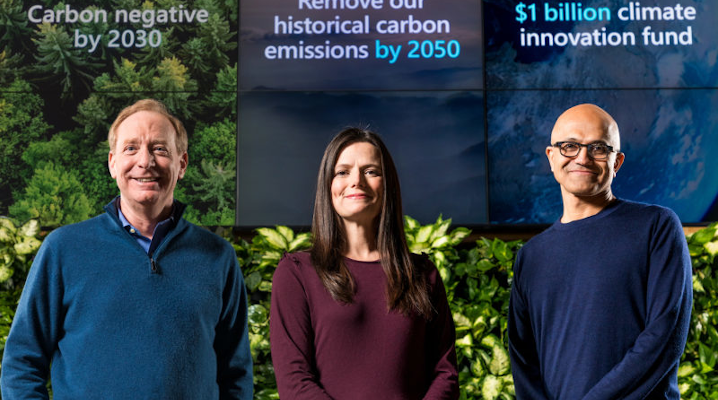 INFRA
INFRA
 INFRA
INFRA
 INFRA
INFRA
Microsoft Corp. today said that it will launch a $1 billion environmental technology fund as part of a broad, multipronged plan to become “carbon negative” by 2030.
The initiative was unveiled at a special event hosted by Chief Executive Officer Satya Nadella (pictured, right), Chief Financial Officer Amy Hood (center) and President Brad Smith (left). Smith shared a more in-depth overview of Microsoft’s roadmap in a blog post this morning.
One of the pillars of the initiative is the newly inaugurated Climate Innovation Fund, which the company will use to invest $1 billion in the development of new technologies with the potential to curb carbon emissions. The capital will be deployed over the next four years. Microsoft plans to provide financing for research projects that are already ongoing, as well back startups working on “new innovations” with equity and debt capital.
The hope is that technologies developed with support from the fund will eventually help the company reduce its own environmental impact.
This year, Microsoft projects that its business activities will lead to the release of 16 million metric tons of CO2 into the atmosphere. About a quarter of that is expected to come directly from the company’s operations while the rest will be generated by indirect sources, such as electricity consumed by customers’ Windows computers. Microsoft’s plan to go carbon negative calls for the company to take more CO2 out of the atmosphere than it produces starting in 2030.
The plan will be implemented incrementally. This July, the company intends to impose an internal carbon tax on its business divisions that will be used to fund sustainability projects. Then, in July of 2021, Microsoft will implement a new procurement process that will encourage suppliers to “implement consistent and accurate reporting and pursue effective steps to make progress against scientifically based targets,” Smith wrote in his post.
A third milestone is expected be reached in 2025. Over the next five years, Microsoft hopes to switch all core operations to renewable energy.
“We will shift to 100 percent supply of renewable energy, meaning that we will have power purchase agreements for green energy contracted for 100 percent of carbon emitting electricity consumed by all our data centers, buildings and campuses,” Smith detailed.
These steps and other future moves, including a planned switch to electric vehicles in Microsoft’s corporate fleet, are expected to halve its emissions to about 8 million metric tons annually. The company plans to make up for the rest by investing in initiatives that take carbon out of the atmosphere. Microsoft is looking at established approaches such as reforestation, as well as emerging technologies such as direct air capture machines that pull CO2 from the air.
Microsoft’s fellow tech giants are also investing in sustainability. This past September, Amazon.com Inc. pledged to become fully carbon neutral by 2040 and Google LLC signed what it described as its biggest-ever renewable energy procurement deal. In April, Apple inc. said that the number of suppliers using renewable energy to make parts for its products had doubled year-over-year.
Support our mission to keep content open and free by engaging with theCUBE community. Join theCUBE’s Alumni Trust Network, where technology leaders connect, share intelligence and create opportunities.
Founded by tech visionaries John Furrier and Dave Vellante, SiliconANGLE Media has built a dynamic ecosystem of industry-leading digital media brands that reach 15+ million elite tech professionals. Our new proprietary theCUBE AI Video Cloud is breaking ground in audience interaction, leveraging theCUBEai.com neural network to help technology companies make data-driven decisions and stay at the forefront of industry conversations.